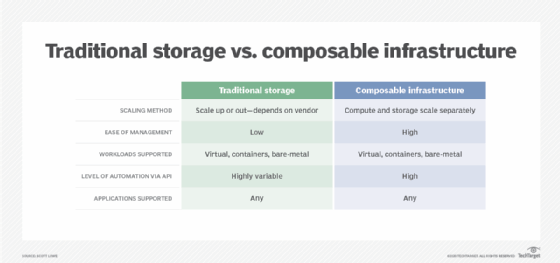
Getty Images
Composable infrastructure providers tackle modern workloads
Composable infrastructure vendors include titans in IT like Dell and HPE, but also startups such as Fungible and Liqid. Explore product features and the tech's pros and cons.
Composable infrastructure providers claim to deliver high flexibility and a cost-effective answer to compute, storage and network needs. This competitive market's products offer a wide range of support for IT admins to consider.
Modern applications and development methodologies need responsive infrastructure. Composable infrastructure -- also referred to as composable disaggregated infrastructure (CDI) -- abstracts compute, storage and network resources and delivers them as services that organizations can allocate to workloads on demand.
The result is more efficient operations, improved resource use and better performance. Composable infrastructure can also support a wide range of workloads, whether in containers, in VMs or on bare metal. Because of this flexibility, organizations can respond quicker to changing business needs and support all types of applications.
Composable infrastructure can offer cost advantages because it centralizes management and reduces the administrative overhead and number of support calls. Organizations can use the infrastructure on commodity hardware, which leads to more savings and provides the flexibility necessary to support evolving workloads.
Top vendors and services
In anticipation of expected growth, composable infrastructure providers have steadily improved and expanded their products.
Dell EMC PowerEdge MX includes a scalable fabric architecture that can extend services across multiple chassis but manage them as if they were a single system.
The Fungible data processing unit (DPU), along with its TrueFabric protocol, makes it possible to disaggregate and pool compute, storage and network resources. The DPU can offload all infrastructure services from the x86 processors to deliver bare-metal performance and high scalability.
HPE has partnered with numerous companies to enhance its composable ecosystem. For example, Docker now integrates with HPE's OneView infrastructure management software. In addition, HPE has released a reference configuration for delivering Docker containers as a service on Synergy. HPE has also formed partnerships with vendors such as Red Hat, Morpheus, Ansible, Arista, ServiceNow and VMware.
The Lenovo ThinkAgile CP platform includes a centralized, cloud-based management tool that automates the discovery, deployment and configuration of resources. It supports automated, nondisruptive software updates. The platform also includes an integrated application marketplace and end-to-end automation.
The Liqid CDI platform offers multifabric composability across PCIe, Ethernet and InfiniBand connections. The platform claims to support next-generation applications and accommodate upcoming fabric updates, such as Gen-Z, Compute Express Link and Cache Coherent Interconnect for Accelerators. The Liqid platform can build resource pools based on a wide range of physical devices. The options include the typical compute, storage and network resources, as well as hardware such as GPUs, field-programmable gate arrays, Intel Optane memory devices, and PCIe storage and accelerator resources.
With its focus on software-defined servers, TidalScale takes a leap into the future by aggregating core, memory and I/O resources across multiple physical servers to create a single virtual server. It doesn't require changes to the hardware, OS or applications. TidalScale uses real-time machine learning to continually update CPU and memory locations across physical computers to optimize performance as workloads shift.
The Western Digital OpenFlex platform uses NVMe-oF to optimize performance and reduce latency. The product enables data access from anywhere in the data center. The platform also supports the Open Composable API, which was designed to treat resources as peer elements that work together to support their target workloads.

Composable infrastructure market needs and challenges
Despite the rising growth of the CDI industry, composable infrastructure has challenges. For example, organizations that plan to roll out their own CDI platforms might not have the IT expertise they need to implement and maintain them. Such expertise might be difficult to find, at least in the near term, because the industry is still nascent. However, this issue could improve as composability becomes a more common approach to infrastructure.
Some composable systems use PCIe technology to interconnect infrastructure. Although PCIe delivers high bandwidth and low latency, it also comes with higher port costs than Ethernet. It could impose limitations on cable length, confining the fabric to a single rack. Certain products might impose their own technical limitations. For example, HPE Synergy supports only Ethernet and Fibre Channel for storage.
It will be difficult for composable infrastructure providers to achieve the type of market acceptance that the converged and hyper-converged markets have won. According to a Statista survey of IT executives and managers, in 2020, only 11% of respondents had implemented composable systems in production, while 52% showed no interest in the technology. In fact, CDI generated the lowest level of interest across the 10 technologies surveyed.
Even organizations ready to embrace CDI must consider that transitioning to a new infrastructure model can take time and resources, which for some is difficult to justify. CDI products often come with limitations in fabric, hardware or scalability, and many can lead to vendor lock-in.
Given these restrictions, it might take time for composable infrastructure providers to generate enthusiasm among their potential customers. But they can help this effort by addressing these limitations. More importantly, they can deliver truly composable infrastructure that spans fabrics and distances and pools all types of resources, without limiting customers or putting them at risk for lock-in.






